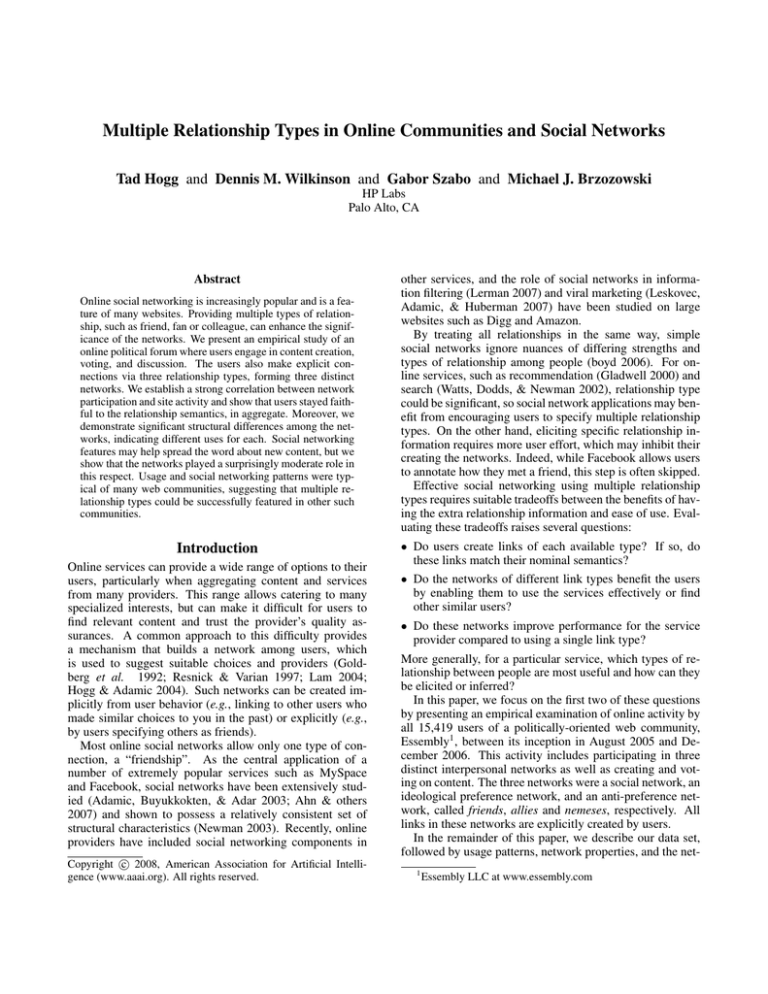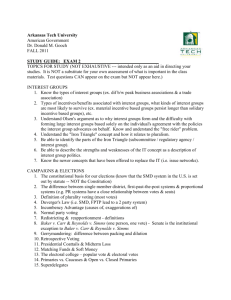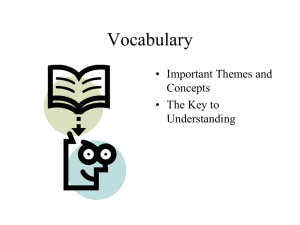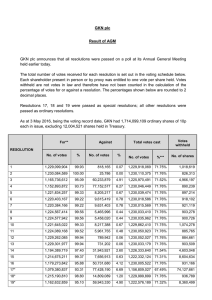
Multiple Relationship Types in Online Communities and Social Networks
Tad Hogg and Dennis M. Wilkinson and Gabor Szabo and Michael J. Brzozowski
HP Labs
Palo Alto, CA
Abstract
Online social networking is increasingly popular and is a feature of many websites. Providing multiple types of relationship, such as friend, fan or colleague, can enhance the significance of the networks. We present an empirical study of an
online political forum where users engage in content creation,
voting, and discussion. The users also make explicit connections via three relationship types, forming three distinct
networks. We establish a strong correlation between network
participation and site activity and show that users stayed faithful to the relationship semantics, in aggregate. Moreover, we
demonstrate significant structural differences among the networks, indicating different uses for each. Social networking
features may help spread the word about new content, but we
show that the networks played a surprisingly moderate role in
this respect. Usage and social networking patterns were typical of many web communities, suggesting that multiple relationship types could be successfully featured in other such
communities.
other services, and the role of social networks in information filtering (Lerman 2007) and viral marketing (Leskovec,
Adamic, & Huberman 2007) have been studied on large
websites such as Digg and Amazon.
By treating all relationships in the same way, simple
social networks ignore nuances of differing strengths and
types of relationship among people (boyd 2006). For online services, such as recommendation (Gladwell 2000) and
search (Watts, Dodds, & Newman 2002), relationship type
could be significant, so social network applications may benefit from encouraging users to specify multiple relationship
types. On the other hand, eliciting specific relationship information requires more user effort, which may inhibit their
creating the networks. Indeed, while Facebook allows users
to annotate how they met a friend, this step is often skipped.
Effective social networking using multiple relationship
types requires suitable tradeoffs between the benefits of having the extra relationship information and ease of use. Evaluating these tradeoffs raises several questions:
Introduction
• Do users create links of each available type? If so, do
these links match their nominal semantics?
Online services can provide a wide range of options to their
users, particularly when aggregating content and services
from many providers. This range allows catering to many
specialized interests, but can make it difficult for users to
find relevant content and trust the provider’s quality assurances. A common approach to this difficulty provides
a mechanism that builds a network among users, which
is used to suggest suitable choices and providers (Goldberg et al. 1992; Resnick & Varian 1997; Lam 2004;
Hogg & Adamic 2004). Such networks can be created implicitly from user behavior (e.g., linking to other users who
made similar choices to you in the past) or explicitly (e.g.,
by users specifying others as friends).
Most online social networks allow only one type of connection, a “friendship”. As the central application of a
number of extremely popular services such as MySpace
and Facebook, social networks have been extensively studied (Adamic, Buyukkokten, & Adar 2003; Ahn & others
2007) and shown to possess a relatively consistent set of
structural characteristics (Newman 2003). Recently, online
providers have included social networking components in
c 2008, American Association for Artificial IntelliCopyright °
gence (www.aaai.org). All rights reserved.
• Do the networks of different link types benefit the users
by enabling them to use the services effectively or find
other similar users?
• Do these networks improve performance for the service
provider compared to using a single link type?
More generally, for a particular service, which types of relationship between people are most useful and how can they
be elicited or inferred?
In this paper, we focus on the first two of these questions
by presenting an empirical examination of online activity by
all 15,419 users of a politically-oriented web community,
Essembly1 , between its inception in August 2005 and December 2006. This activity includes participating in three
distinct interpersonal networks as well as creating and voting on content. The three networks were a social network, an
ideological preference network, and an anti-preference network, called friends, allies and nemeses, respectively. All
links in these networks are explicitly created by users.
In the remainder of this paper, we describe our data set,
followed by usage patterns, network properties, and the net1
Essembly LLC at www.essembly.com
works’ relation to user behavior. We conclude with a discussion of our results and possible future work.
500
450
400
Essembly is an online service helping users to engage in political discussion and organization. Essembly allows members to post resolves reflecting controversial issues, e.g.
“Overall, free trade is good for American workers.” Other
members can then vote on these resolves, using a four-point
scale: Agree, Lean Agree, Lean Against and Against. Users
can only vote once, and all their votes are viewable by other
members, forming an ideological profile.
During their sign up, new users are encouraged to vote
on ten initial resolves to create an ideological profile. Subsequent votes on other, user-generated resolves update their
profiles. Votes on the ten initial resolves do not reflect any
mechanism for content discovery so we do not consider
them in our study of network use. For the remainder of
this paper, we use “resolve” to mean the 25953 user-created
resolves, and consider only votes on user-created resolves,
unless otherwise noted.
The distinct social and ideological networks enable users
to distinguish between people they know personally and
people encountered on the site with whom they tend to agree
or disagree. Network links are formed by invitation only and
each must be approved by the invitee. Thus all three networks in Essembly are explicitly created by users and are
symmetric (i.e., undirected). Essembly users can identify
potential allies or nemeses by comparing ideological profiles. The Essembly user interface presents several options
for users to discover new resolves, based on votes by network neighbors, recency, overall popularity, and degree of
controversy. Essembly is well-suited to a study of multiple
relationship types because it provides the networks and easily quantifiable behavior using those networks.
Our data set consists of fully anonymized voting records
and network connections, representing a complete history
of voting activity on the site during the study period and
the final state of the three networks.2 The data set does not
include the content of the resolves, the history of link formation in the networks nor which of the two users involved
initiated the formation of each link.
User behavior and network structure
In this section we present results on patterns of user activity
and details of network structure. We also show the relation
between user-user homophily and distance in the network.
Usage patterns
The first question we address is whether user behavior in Essembly is similar to that seen in many other social network
web sites. 12,440 users voted on resolves, casting a total
of 1.3 million votes. The distribution of votes per user is
heavy tailed, with a few very active users making a disproportionately large number of votes: the top 5% of users cast
2
The data also includes the time and length of each comment
posted for a resolve and the number of responses to that comment.
Number of resolves
Essembly
350
300
250
200
150
100
50
0 0
10
1
10
2
10
3
10
4
10
Number of votes to one resolve
Figure 1: The frequency distribution of resolves vs. number of votes. The solid line indicates a lognormal fit to the
data points, where the mean and standard deviation of the
variate’s logarithm are 3.7 and 0.62, respectively.
81% of the votes and the top 1% cast 44%. Such a distribution also occurs in other online services, notably Wikipedia
editing (Wilkinson & Huberman 2007), Digg recommendations (Lerman 2007), and Facebook messaging (Golder,
Wilkinson, & Huberman 2007).
Our data has 24,953 resolves, averaging 52.6 votes. Fig. 1
shows the distribution of votes per resolve is heavy tailed,
although not nearly as skewed as the votes per user. The
points are approximately a lognormal distribution, which
arises from a decaying multiplicative reinforcement mechanism where resolves accrue votes at a rate proportional to
the number of votes they already have (Wu & Huberman
2007). Such a mechanism may arise for several reasons,
including global popularity-based search (Limpert, Stahel,
& Abbt 2001; Mitzenmacher 2004; Huberman & Adamic
1999) and network diffusion3 (Leskovec, Adamic, & Huberman 2007).
Networks and user participation
This section describes correlations between network participation and voting activity. 5,358 Essembly users (43%) participated in at least one network. The top of Table 1 lists
the total nodes and links for each network. Users with network links were much more active than the others, accounting for 96% of all votes. The average number of votes per
networked user was 286, versus 6 for non-networked users,
a statistically significant difference4 .
Fig. 2 shows many users participated in more than one
network. Most interested, dedicated users adopted Essembly’s multiple relationship types: of the 622 users in the top
5% of voting activity, 85% were in at least two networks.
The voting activity section of Table 1 shows networked
users have a positive Pearson correlation between voting and
3
Network diffusion assumes users of different degrees are wellmixed, as is the case in the Essembly networks as we later show.
4
Wilcoxon rank sum test, p < 10−12
A, N only
63
(535)
N only
22
(18)
F, N only
121
(63)
N
A
965
(856)
390
(91)
1843
(200)
F
1944
(29)
no network
7082
(6)
Figure 2: Number of users, and their average numbers of
votes in parentheses, who are in each combination of networks. Labels F, A and N denote the friends, allies and
nemeses networks, respectively.
degree in all three networks. Thus not only are networked
users more active than non-networked, we find dedicated
users tended to use both the networking and voting features.
Network structure
This section presents the structure of the three Essembly networks. Each network has a heavy-tailed degree distribution,
which is fairly well approximated by a truncated power law:
the fraction of nodes of degree d is proportional to d−τ e−d/κ
except the top percent of degrees are somewhat larger than
this fit suggests. Table 1 quantifies the degree distributions.
Such a skewed distribution is typical of online social networks (Newman 2003). The truncated power law can arise
from a combination of preferential attachment and users becoming inactive (Amaral et al. 2000).
The three networks contain few common links:
P (allies|friends) = 29%
P (friends|allies) = 25%
P (nemeses|friends) = 3% P (friends|nemeses) = 20%
This reflects one purpose of the ideological networks in
Essembly, namely to help users find others with similar
views beyond their friends5 . This observation is consistent
with users creating links with different nominal semantics.
Each network has a giant connected component containing all the high degree nodes and most low degree nodes.
Thus most nodes, including all the most highly connected,
are reachable from most other nodes by following network
links. Large online social networks that have been studied
have a giant component (Newman 2003).
The networks differ in structure within their giant components, as indicated in the community structure section of
Table 1. One example is the difference in transitivity, a
measure of local clustering in a graph given by the average
over the nodes of the ratio of existing links to possible links
among each user’s first neighbors (Watts & Strogatz 1998).
5
A few (122) alliances are also nemeses, but most of these (88)
are also friends. So the majority of users seem to see allies and
nemeses as mutually exclusive. We discarded the small minority
who didn’t (less than 1% of all relationships) in the homophily
plots and decision tree analysis below.
network
nodes
links
friends allies
4873
3261
13516 15593
community structure
transitivity
0.31
0.19
modularity
0.73
0.47
average path length
4.67
3.77
degree distribution
1.2
1.2
power law tail, τ
cutoff, κ
27
57
2
3
median
maximum
274
382
−0.02 −0.11
degree assortativity
components
giant component fraction
0.87
0.96
229
59
number of components
voting activity
correlation with degree
0.28
0.51
voting assortativity
0.22
0.06
nemeses
1181
2075
0.02
0.56
4.37
1.4
18
2
125
−0.15
0.85
77
0.34
0.01
Table 1: Properties of the three Essembly networks. The
quantities are described in more detail in the text.
Social networks typically have values from 0.3 to 0.8 (Newman 2003). A broader measure of community structure is
modularity which characterizes the extent to which the network clusters into well-defined communities, with reported
values for social networks in the range 0.4 − 0.9 (Newman
2006). The values in Table 1 are estimates with a greedy
algorithm for community structure (Clauset 2005). Both
modularity and transitivity are higher for the friends network
than for the other two networks, with especially small transitivity among nemeses. The friends network is thus moderately clustered, while users in the allies and nemeses networks have less well-defined communities.
To check these conclusions on community structure differences, we compared the differences in these values between each pair of networks with what one would expect
under the hypothesis that users selected the type of link for
each network in the pair randomly but in the same proportion as in the actual networks. This randomization test (Cohen 1995) showed the differences we observed are unlikely
(with p-value less than 5% in all cases) to arise with random
link type choices.
Another important difference in the networks is the average path length, the average shortest distance between all
pairs of nodes in the giant component. The path lengths reported in Table 1 show the networks have the small world
property typical of social networks (Newman 2003). The
relatively high average path length in the friends network is
related to its high modularity. Users tend to form closelyknit communities in the friends network, so that one or two
inter-community links are often required to connect pairs of
nodes. By contrast, the allies network is more dense and
star-like, with most users directly connected to the core of
high degree nodes.
Taken together, these observations indicate a friends net-
work typical of online social networks, a star-like allies
network with structure similar to the Internet (on a much
smaller scale), and a sparse nemeses network.
We gain further insight into the networks by comparing
how links relate to two measures of activity in Essembly:
forming links and voting. Degree and voting assortativity
measure the tendency of people with similar levels of those
activities to link to each other. Table 1 shows Essembly’s
degree assortativity is negative and lower than that of other
online social networks (Newman 2003) whereas the voting
assortativity is positive. Thus users with many neighbors
tend to link to people with few neighbors, while active voters tend to link to other active voters. One explanation for
this contrast is that Essembly facilitates finding other users
through their votes rather than only their networks.
Friends tend to display a certain level of homophily, that is,
similarity of opinion or interest (McPherson, Smith-Lovin,
& Cook 2001). Homophily between Essembly users can be
estimated by comparing the votes they make on resolves in
common. In this section we compare user homophily to distance in the networks, which suggests users are faithful to
link semantics when making connections.
Essembly calculates homophily and allows members to
compare themselves to other users whether they are network
neighbors or not. In light of the four-point voting scale, Essembly uses the following L1 metric6 , which we also adopt:
X 1
1
S(a, b) = 1 −
(|V (a, r) − V (b, r)|) (1)
|Ra,b |
3
r∈Ra,b
where V (a, r) is the numerical value of the vote of user a
on resolve r and Ra,b is the set of resolves both a and b have
voted on7 . There is a moderate overall tendency to agree:
the median homophily over all networked users is 0.64.
Fig. 3 shows homophily levels for first neighbors in the
three networks, as well as randomly selected pairs. Friends
and allies tend to be more ideologically similar (medians
0.71 and 0.77, respectively), while nemeses are decidedly
dissimilar (median 0.43). People are more likely to agree
with their allies than their friends, and with their friends than
their nemeses. This provides evidence that the three semantically distinct networks capture different levels of ideological homophily.
Fig. 4 shows how homophily varies with distance in the
networks and suggests that the links correspond to their
nominal interpretation. The behavior for the nemeses network is particularly striking, indicating that, in Essembly,
the enemy of my enemy could be my friend or ally. The oscillations in the nemeses curve show this behavior continues
far into the network, in spite of averaging over many users.
6
Chris Chan, personal communication
We include the ten initial resolves in this analysis. Essembly
does not include user-designated “just for fun” resolves in its calculation, but this distinction was not made in our data so we included
all resolves.
7
Friends
Random
Nemeses
0
0.2
0.4
0.6
Ideological similarity
0.8
1
Figure 3: Distribution of vote similarities for pairs of users
who have voted on at least 10 resolves in common. Curves
are for neighbors in the three networks, as well as random
pairs of users.
0.8
allies
friends
nemeses
overall average
0.75
0.7
average similarity
User homophily and network distance
Allies
0.65
0.6
0.55
0.5
0.45
1
2
3
4
5
distance in the network
6
7
8
Figure 4: Vote similarities vs. distance in friends, allies and
nemeses networks (blue, green and red curves, respectively).
The curves use the similarity measure of Eq. (1).
Network effect on voting
A basic application of a social network in an online service
is to spread information about site content. In this section we
examine the role of the Essembly networks in encouraging
voting. We find a moderate overall effect but strong effects
for certain combinations of factors.
One way to measure the network effect is to count the
number of votes cast by users before any of their network
neighbors have voted. These votes are certainly not inspired
by a neighbor’s vote and we will refer to them as seeds. The
percentage of seeds is not a useful measure by itself, because
it is impossible to tell (given our data) whether a non-seed
resulted from network influence.
To establish the significance of the percentage seed votes,
we performed a randomization test where the actual voting
histories were compared to simulated histories where users
“voted” on resolves with no regard to the network structure.
1
actual data
randomization test
0.9
Proportion of seed votes
0.8
0.7
0.6
0.5
0.4
allies
0
0
0
0
1+
nemeses
0
0
0
2+
0
1+
Posterior Pvote
44%
65%
73%
38%
49%
49%
N
804,299
96,910
3,022
12,462
604,042
825,656
0.3
0.2
0.1
0
10
20
30
40
50
60
70
Number of previous votes on resolve
80
90
100
Figure 5: Percentage of seed votes (votes cast prior to any
network neighbor voting) as a function of the number of previous votes. The percentages are averages over resolves.
Standard deviations (not pictured) are on the order of 0.01
for all data points.
In these simulated histories, users were constrained to vote
with the same frequency as in the real data, and resolves
constrained to accumulate votes at the real rate, but beyond
these constraints users chose resolves at random8 .
Fig. 5 shows the difference in percentage of seed votes for
the actual history compared to the average of a number of
randomization tests. We see this difference regardless of the
number of votes a resolve received. The comparison of seed
vote percentage shows a statistically significant, if moderate, network effect. Because the networks are rather dense,
with highly active users also having many network connections, the subnetwork of voters on a given resolve quickly
percolated throughout the overall network. That is, a giant
connected component of voters formed in the real data and
the randomization tests, after only a few votes. Indeed, the
real data and the randomization tests had statistically indistinguishable percentage of voters in the giant component for
resolves with more than 50 votes. This result highlights the
importance of high-degree nodes in the process of spreading
new content, no matter what the mechanism.
On the other hand, in a few cases where relatively large
numbers of network neighbors voted previously, we find
significant correlations using a decision tree analysis (Brzozowski, Hogg, & Szabo 2008). We considered all 1.3 million votes. To identify when networks may have been particularly influential we needed examples where users could
have voted on a resolve but didn’t. We created these examples by inferring user sessions: periods of activity for a given
user, punctuated by three or more hours without any votes.
8
friends
0
1+
4+
0
0
0
These tests used only the 2000 resolves created during the
month ending Nov. 22, 2006, giving both nearly complete networks and sufficient time to accumulate votes. Specifically, these
resolves are from near the end of our data sample, so the networks
were likely almost all established before these resolves. Furthermore, these resolves were created at least 20 days before the end
of our sample, on Dec. 12, 2006, giving enough time to accumulate most of their votes: on average, a resolve received 93.6% of its
votes in the first 20 days after its introduction.
Table 2: Posterior probability of voting, as a function of how
many friends, allies, and nemeses voted previously. N is
the number of samples for each of the cases. The last row
corresponds to having at least one ally or nemeses. (The
prior probability is set at Pvote = 50%.)
At the end of each session, for each vote a user placed during
the session, we created one negative example by randomly
selecting a resolve the user could have voted on (from the set
of all resolves that existed at the time) but didn’t. This gives
roughly equal numbers of positive and negative examples.
We learned a decision tree over the complete set of examples using (Chickering 2002). The leaves reflect the portion
of cases where a user voted under the given conditions, relative to the prior distribution (Pvote = 1/2). As features we
used the number of friends, allies, and nemeses who’d voted
previously and thus could have shown up on a user’s home
page as an influence.
Table 2 shows some results from the leaves of the tree.
Rows 1 and 2 suggest users are 48% (i.e., 65/44 − 1 =
0.48) more likely to vote on a resolve if one or more of their
friends voted on it than if none of their neighbors did (p <
0.001). By contrast, if four or more friends (and no other
neighbors) voted on a resolve already, users are 66% more
likely to vote on it (Table 2 rows 1-3). Curiously, when two
or more nemeses voted on a resolve (but no friends or allies),
the posterior Pvote drops, to 38%: a user is 14% less likely
to vote on a resolve if two or more nemeses voted on it than
if no one in his or her local networks did (p < 0.001; Table 2
rows 1, 4).
Essembly encourages users to vote on resolves voted on
by their allies, and there are indeed many examples where a
user sees only allies voting on a resolve. However, users are
not significantly more likely to vote on resolves their allies
have voted on (Table 2 row 5). Users are also 33% more
likely to vote on a resolve that friends voted on than some
combination of allies and nemeses (p < 0.001; Table 2 rows
2, 6). This suggests that friends are more influential than
allies or nemeses in selecting resolves.
Discussion
We examined user activity and network connections from
Essembly, an online service for people interested in political
discussion and organization. Essembly provides three different relationship types, creating three separate networks
of the same users. Our results show Essembly is a useful
test case of an online social network allowing multiple relationship types. Furthermore, Essembly users follow typical
patterns of activity and social network structure, so these observations may generalize to other online communities.
Users were faithful to the link semantics and the networks
had different structural and functional properties, suggesting
that distinct networks may have useful applications. For example, friends connections are most relevant to applications
related to communities and persuasion. The allies network
is well-suited to the rapid spread of information and forming significant collaborations. Our observation that nemesis activity inhibits voting suggests that a “nemeses” network could function as an ignore list, possibly overlaid on a
friends network, for people to identify users whose content
choices are not likely to be interesting. The high homophily
demonstrated by enemies of enemies suggests the nemesis
network could also identify potential allies. This behavior
is analogous to the propagation of trust and distrust in networks (Guha et al. 2004).
The networks played a surprisingly moderate role in
spreading new content, with network connections becoming
more important as resolves age. This contrasts with other
web sites, such as Digg (Lerman 2007), where new content
is not shown on the main page until it achieves a certain
level of popularity and early votes are mostly within the networks. This suggests that novelty and overall popularity are
powerful means of spreading content even in the presence
of a social network. These mechanisms could be included
in our analysis as resolve features, such as its age or overall
popularity, independent of network neighbors.
It would be interesting to model voting behavior based
on the approaches the Essembly user interface provides for
finding resolves, e.g., recent, popular, controversial or active
among user’s network neighbors. It would also be useful
to compare multiple network types on the same set of users
in other situations, especially with records of link creation
times, and perform intervention experiments to help identify
which correlations in behavior are causal (e.g., by changing
types of links available to different subgroups of users).
Online social networks allow incorporating relationship
information into web services and economic mechanism designs. When it is useful to match semantics of a link to its
use, Essembly shows it is feasible to have users explicitly
specify multiple link types relevant to their task. Distinguishing homophilous or other attributes of interest from
friendship adds meaning to each, in particular, easing the
burden on the socially loaded concept of friendship.
Acknowledgments
We thank Chris Chan and Jimmy Kittiyachavalit of Essembly for
their help in accessing the Essembly data. We thank Scott Golder
for helpful comments.
References
Adamic, L. A.; Buyukkokten, O.; and Adar, E. 2003. A social
network caught in the web. First Monday 8(6).
Ahn, Y.-Y., et al. 2007. Analysis of topological characteristics
of huge online social networking services. In Proc. of 2007 Intl.
Conf. on the World Wide Web, 835–844.
Amaral, L. A. N.; Scala, A.; Barthelemy, M.; and Stanley, H. E.
2000. Classes of small-world networks. Proc. of the Natl. Acad.
Sci. 97:11149–11152.
boyd, d. 2006. Friends, friendsters, and top 8: Writing community
into being on social network sites. First Monday 11(12).
Brzozowski, M.; Hogg, T.; and Szabo, G. 2008. Friends and foes:
Ideological social networking. In Proc. of the SIGCHI Conference
on Human Factors in Computing (CHI2008). ACM Press.
Chickering, D. M. 2002. The WinMine toolkit. Technical Report
MSR-TR-2002-103, Microsoft.
Clauset, A. 2005. Finding local community structure in networks.
Physical Review E 72:026132.
Cohen, P. R. 1995. Empirical Methods for Artificial Intelligence.
Cambridge, MA: MIT Press.
Gladwell, M. 2000. The Tipping Point: How Little Things Can
Make a Big Difference. Boston: Little Brown.
Goldberg, D.; Nichols, D.; Oki, B. M.; and Terry, D. 1992. Using
collaborative filtering to weave an information tapestry. Communications of the ACM 35(12):61–70.
Golder, S. A.; Wilkinson, D. M.; and Huberman, B. A. 2007.
Rhythms of social interaction: Messaging within a massive online network. In Proc. of the 3rd Intl. Conf. on Communities and
Technologies (CT2007).
Guha, R.; Kumar, R.; Raghavan, P.; and Tomkins, A. 2004. Propagation of trust and distrust. In Proc. of the 13th Intl. World Wide
Web Conf. (WWW2004), 403–412. New York: ACM.
Hogg, T., and Adamic, L. 2004. Enhancing reputation mechanisms via online social networks. In Proc. of the 5th ACM Conference on Electronic Commerce (EC’04), 236–237. ACM Press.
Huberman, B. A., and Adamic, L. A. 1999. Growth dynamics of
the World Wide Web. Nature 401:131.
Lam, C. 2004. SNACK: incorporating social network information in automated collaborative filtering. In Proc. of the 5th ACM
Conference on Electronic Commerce (EC’04), 254–255. ACM
Press.
Lerman, K. 2007. Social information processing in social news
aggregation. preprint arxiv.org/abs/cs.cy/0703087.
Leskovec, J.; Adamic, L. A.; and Huberman, B. A. 2007. The
dynamics of viral marketing. ACM Transactions on the Web 1(1).
Limpert, E.; Stahel, W. A.; and Abbt, M. 2001. Log-normal distributions across the sciences: Keys and clues. BioScience 51:341–
352.
McPherson, M.; Smith-Lovin, L.; and Cook, J. M. 2001. Birds
of a feather: Homophily in social networks. Annual Review of
Sociology 27:415–444.
Mitzenmacher, M. 2004. A brief history of generative models
for power law and lognormal distributions. Internet Mathematics
1:226–251.
Newman, M. E. J. 2003. The structure and function of complex
networks. SIAM Review 45(2):167–256.
Newman, M. E. J. 2006. Modularity and community structure in
networks. Proc. Natl. Acad. Sci. USA 103:8577–8582.
Resnick, P., and Varian, H. R. 1997. Recommender systems.
Communications of the ACM 40(3):56–58.
Watts, D. J., and Strogatz, S. H. 1998. Collective dynamics of
‘small-world’ networks. Nature 393:440–442.
Watts, D. J.; Dodds, P. S.; and Newman, M. E. J. 2002. Identity
and search in social networks. Science 296:1302–1305.
Wilkinson, D. M., and Huberman, B. A. 2007. Assessing the
value of cooperation in Wikipedia. First Monday 12(4).
Wu, F., and Huberman, B. A. 2007. Novelty and collective attention. Proc. of the Natl. Acad. Sci. 104:17599–17601.






